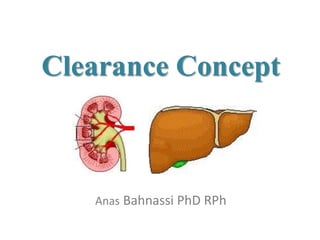
Pharmacokinetics: Lecture Three
- 1. Clearance Concept Anas Bahnassi PhD RPh
- 2. Lecture Objectives After the completion of this lecture the student should be able to: 1. Define clearance and extraction ratio and describe the relationship between them. 2. Distinguish clearance from elimination rate and elimination rate constant. 3. Explain the dependence of elimination half life on apparent volume of distribution and clearance 4. Calculate area under the plasma drug concentration versus time curve by use of the trapezoidal rule and by other methods 5. Calculate a patient’s creatinine clearance using the appropriate equation 6. Calculate dosing adjustments of a renally excreted drug in patients with various degrees of renal impairment (dysfunction).
- 3. A Physiological Approach to Understand Clearance Concept Site of Action Heart Clearing Organ (Pump) (Kidney/Liver) The blood exiting the eliminating organ has a lower concentration than the blood entering the organ. The efficiency of Removal is quantified by the Extraction Ratio [ER].
- 4. Extraction Ratio Extraction Ratio can be defined as the proportion of drug removed during passage through the organ. Ca Cv ������������ − ������������ ������������ = ������������
- 5. Clearance A proportionality constant describing the relationship between a substance’s rate of elimination (amount per unit time) at a given time and its corresponding concentration Clearance in an appropriate fluid at that time. is: The hypothetical volume of blood (plasma or serum) or other biological fluids from which the drug is totally and irreversibly removed per unit time.’ Organ clearance = Blood flow rate X Extraction ratio ������������ = ������. ������������
- 6. Hepatic Types of Clearance Clearance Renal Clearance The clearance of drug (a Metabolic fraction of total clearance) Clearance for a drug that is removed from the blood This is the total of every (plasma/serum) by individual organ clearances the process of renal that contribute to the excretion. elimination of drugs. However, the organ clearance that can be routinely determined independently in humans is renal clearance ������������������������������������������ = ������������������������������������������ + ������������������������������ ������������������������������ because this is the only organ for which we can easily determine an elimination rate.
- 7. Clearance is a proportionality constant that relates rate of elimination (rate of excretion in renal clearance) to Plasma (or serum) concentration at any given time ������������������ ������ = ������������������ ������������ ������ ������������ ������������ ������ = ������������ ������������ ������ ������������ ������������ = ������������
- 8. Elimination half-life vs. Clearance 0.693 ������������ = ������������ ������½ = ������ 0.693������ ������½ = ������������ Elimination half life is dependent on the volume of distribution and total clearance
- 9. Calculating Clearance ������������������ IV Bolus ������ = ������������������ ������������ ������ ������������ Clearance for the entire dose can be obtained by integrating the right hand side of the equation from t=0 to t= ������=∞ ������������ ������������ ������������������������������ ������������������������������������������������������������������ (������������������������) ������������ ������������ ������ = = ������. ������������ ������������������������������ ������������������������ ������������������������������ ������ℎ������ ������������������������������ ������=0
- 10. Calculating AUC IV Bolus s ������+������ ������ Area = 2 ������ ������ ������
- 11. Calculating AUC Trapezoidal Rule: C1 or concentration1 C2 or concentration2 t1 or time1 t2 or time2 Area = ((C1 + C2)/2)(t2 – t1)
- 12. ������=∞ Calculating AUC ������. ������������ Trapezoidal Rule: ������=������ C1 or concentration1 C2 or concentration2 t1 or time1 t2 or time2 ������=∞ ������. ������������ = Area = Sum individual trapezoids ������=������������������������ =(((C1 + C2)/2)(t2 – t1))
- 13. ������=∞ ������. ������������ Calculating AUC ������=������ Trapezoidal Rule: C1 or concentration1 C2 or concentration2 ∞ ������������������������������������������ t1 or time1 t2 or time2 ������=∞ ������������������������ ������������������������������������������������������������������������������ ������. ������������ = ������=������������������������ ������
- 14. Creatinine Clearance Creatinine clearance (Clcr) is renal clearance (Clr) applied to endogenous creatinine ( a product of muscles metabolism). It is used to monitor renal function and is a valuable parameter for calculating dosage regimens in elderly patients or those suffering from renal dysfunction. Normal creatinine clearance (Clcr) values are: • Adult males: 120±20mLmin-1 • Adult females: 108 ±20mLmin-1.
- 15. Creatinine Clearance Direct measurement of Creatinine clearance Rate of ∆������������ Creatinine Excretion ∆������ ������������������������ = (������������ )������������ Creatinine Serum Concentration
- 16. Creatinine Clearance Indirect measurement of Creatinine clearance Males: ������������������������ℎ������(������������) × (140 − ������������������ ) ������������������������ = 72 × ������������ ������������ (������������%) Females: ������������������������ℎ������(������������) × (140 − ������������������ ) ������������������������ = 0.85 72 × ������������ ������������ (������������%)
- 17. Creatinine Clearance The significance of Creatinine clearance 1. Normal Creatinine clearance usually indicates normal kidney function 2. Creatinine clearance changes with age, physiological states, or other medical conditions and dose need to be changed accordingly 3. Dose frequency can be changed instead of changing the dos amount. 4. Changes in Creatinine clearance cause pharmacokinetic parameters to change.
- 18. Question 1 The table shows the concentration data vs Time Cp (ug/mL) time for Cinoxacin after IV bolus (hr) administration. Plot the data and use the graph to obtain the followings: 0.25 11.6±1.3 1. Elimination half-life (t½) 0.5 8.4±1.0 2. Elimination rate constant (k) 0.75 7.2±1.1 3. Apparent volume of distribution 1 6.1±1.1 4. Systemic clearance (Cls) 1.5 4.2±1.0 5. ∞������������������ 0 2 3.2±0.9 6. Urine samples over 24 h showed the percentage of the administered dose 3 1.9±0.7 recovered unchanged was 50.1%. The rest 4 1±0.4 were metablolites. Determine the renal 6 0.3±0.2 clearance (Clr), metabolic clearance (Clm), 8 0.09±0.1 the excretion rate constant (Ku), and the metabolite rate constant (Km).
- 19. Plasma Concentration vs time Rectilinear Paper 14 12 Plasma Concentration (ug/mL) 10 8 6 4 2 0 0 1 2 3 4 5 6 7 8 9 Time (h)
- 20. Plasma Concentration vs time Semilog Paper 100 Plasma Concentration (ug/mL) t½=1.2h 10 K=0.577h-1 V=20.833L Cls=12.02L/h AUC=20.797u 1 g/mL 0 1 2 3 4 5 6 7 8 9 Ku=0.298h-1 Km=0.287h-1 0.1 0.01 Time (h)
- 21. Pharmacokinetics Anas Bahnassi PhD RPh abahnassi@gmail.com http://twitter.com/abahnassi http://www.linkedin.com/in/abahnassi http://www.udemy.com/pharmacokinetics http://www.slideshare.net/abahnassi http://bahnassi.coursesites.com attribution – non-commercial – share alike
